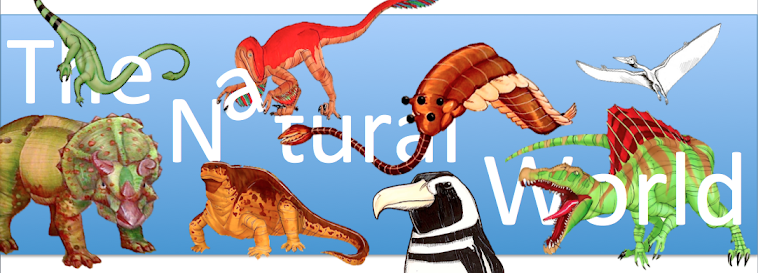You see, 70 million years ago, there were no Rocky Mountains. In fact, Colorado was nowhere near a mile high above sea level: it was about three hundred feet below! Due to the fact that what would one day be Colorado was still located on continental crust, the Western Interior Seaway couldn't be super deep: nevertheless, three hundred feet deep was deep enough to contain an enormous assortment of fun creatures! We've already met a large number of these creatures throughout different posts in the blog, but let's take another look at these guys, as well as other fun filled creatures of this ancient seaway!
Let's start on the shore: multiple dinosaur trackways throughout the nation (including two that I've been to, Dinosaur Ridge near Morrison and the Heritage Museum of the Texas Hill Country) show that many different dinosaurs roamed the shore of the Western Interior, including large ornithopods and large theropods. Some of these dinosaurs actually died and were swept out to shore, such as the ankylosaur Niobrarasaurus!
 |
| Pyg chilling inside of a cast of one of the large ornithopod footprints from Dinosaur Ridge at the Morrison Natural History Museum |
Hesperornis probably ate a wide variety of fish, squid, and an interesting group of extinct marine vertebrates called ammonites. Some ammonites could grow to simply ENORMOUS proportions, such as the one in the top left of the picture below, one from the Heritage Museum of the Texas Hill Country that I mentioned above. Found all over the country (and, as a matter of fact, the world), one particular ammonite site looks like it might be a nesting site! To learn more about this ammonite nesting site, click HERE to check out a guest post by paleontologist and physicist Wayne Itano!
Ammonites were by no means the largest creature in the Western Interior, however, and neither was Hesperornis. As a matter of fact, neither of them were all that close at all! Hesperornis was relatively close to the bottom of the food chain, a fact that we know conclusively due to the discovery of one particular specimen of an interesting animal called Tylosaurus in South Dakota. Tylosaurus was a type of animal called a mosasaur, whose closest living relatives today are the monitor lizards (like the Komodo dragon and the Nile monitor). Contained within the stomach cavity of this particular Tylosaurus specimen were the remains of a fish, a smaller related species of mosasaur, and a Hesperornis! Platecarpus remains, one of those smaller mosasaurs, are sometimes found within the belly of the Tylosaurus, the belly of the beast!
Paleontologists are always very excited when they think they've found the fossilized remains of a predator with the remains of its prey still inside. This can help establish a predator/prey relationship between the two creatures, a relationship that might otherwise have simply been theorized. Fortunately for us paleontologists, multiple critters in the Western Interior Seaway have been discovered with other little critters within their stomach cavity! One of these, which I have nicknamed "The Inception Fossil," we actually did a whole post about a few months back! Entitled "Xiphactinus: The Inception Fossil," this post was all about a fish called Xiphactinus and why I called it "The Inception Fossil." As you might have already guessed from the context, the nickname stems from the "fish within a fish" idea: Xiphactinus is often found with other fish inside of its stomach! Below, you can see one of these Inception Fossils, where a Xiphactinus died shortly after swallowing a fish called Gillicus.
Xiphactinus and Gillicus were by no means the only fish in the sea! The other day, my friend Sam Lippincott and I visited the Denver Gem and Mineral Show. We both purchased several fossils there, and one of my purchases was a small tooth of another Western Interior Cretaceous Seaway (WIKS) fish called Enchodus. The name of this fish roughly translates to "spear fish," and from the picture below, you can probably see why: this fish was definitely made to catch some other fish! Fossils attributed to Enchodus have been found on either side of the K/T boundary, meaning that this fish seems to have survived the extinction that killed off the non avian dinosaurs, and many of the marine creatures as well!
It looks to me like this tooth may be one of the large protruding teeth on the upper part of the jaw.
 |
| Pyg checks out her new Enchodus tooth from the Denver Gem and Mineral Show! |
 |
| Pyg checks out the other tooth she purchased at the Denver Gem and Mineral Show, a Squalicorax tooth! |
Although there were other plesiosaurs that swam through the ancient North American seas, my favorite is the funky looking Dolichorhynchops! This type of short-necked plesiosaur has also been found in the stomach of the enormous Tylosaurus!
Dolichorhynchops is most definitely not a familiar face to your average Joe, but what about Archelon? This massive sea turtle also inhabited the seaway, and is actually the largest sea turtle known to science! This guy is about 13 feet long, which is about twice as long as the leatherback sea turtle, who are the largest living sea turtles! And although Archelon looks similar to sea turtles today, it definitely doesn't look like the turtles we have in Boulder!
Just as the floodwaters are subsiding, so too did the Western Interior Seaway drain from the center of the North American continent. As the Rocky Mountain started getting pushed up and the elevation got higher and higher, the shallow sea got shallower and shallower, until there was nothing left. Nothing left, that is, except for the fossils that we find today! And who knows, maybe the floodwaters from the recent storms have eroded away some overburden, revealing some prehistoric marine fossils beneath!

No comments:
Post a Comment